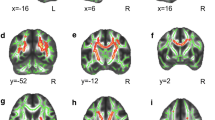Abstract
Recent studies using in vivo proton magnetic resonance spectroscopy (1H MRS) have suggested that plasma phenylalanine (Phe) may not be a reliable indicator of brain Phe level in subjects with phenylketonuria (PKU). Interindividual variation in cerebral Phe can contribute to the phenotypic variability of the disease. We report the results of the direct assessment of brain Phe by 1H MRS in 10 off-diet PKU patients (aged 15.5–30.5 years), 4 detected and treated early, 6 late. In a single patient, brain Phe was evaluated before and 15 days after diet discontinuation. FLAIR MRI and 1H MRS were performed in the same setting by a 1.5 T clinical MR scanner. MR images were scored according to the extent of the lobar white-matter hyperintensity. Brain 1H MRS Phe signal (resonating at 7.36 ppm) was evaluated as a ratio to the creatine+phosphocreatine signal. Brain Phe was correlated with clinical, biochemical and MRI findings. Results were as follows. (1) An abnormal concentration of brain Phe was detected in all 10 PKU subjects (ranging from 0.030 to 0.074), associated with a wide interindividual variability of concurrent plasma Phe (ranging from 724 to 2800 μmol/L). (2) In late-detected subjects, brain Phe concentration correlated with clinical phenotype better than did plasma Phe. The discrepancy between brain and plasma Phe was relevant from a clinical point of view in two cases: in one, a late-detected patient with normal mental development, a high level of plasma Phe was associated with a relatively low concentration of brain Phe; in the other, a late-detected subject with severe neurological impairment, a very high level of brain Phe was associated with plasma Phe compatible with the diagnosis of mild PKU. (3) White-matter alterations were detected in all patients. FLAIR MRI sequences disclosed an involvement of optic chiasma and tracts in 7 subjects. No correlation was found between white-matter alterations and concurrent brain Phe concentrations. (4) In the only case assessed under different intake of Phe, the relevant increase of brain Phe paralleled the concurrent increase of plasma Phe, showing that 1H MRS can be a useful tool in evaluating the individual vulnerability of PKU patients to different values of plasma Phe.
Similar content being viewed by others
REFERENCES
Avision MJ, Herschkowitz N, Novotny EJ, et al (1990) Proton NMR observation of phenylalanine and aromatic metabolite in the rabbit brain in vivo. Pediatr Res 27: 566–570.
Burgard P, Bremer HJ, BÏhrdel P, et al (1999) Rationale for the German recommendations for phenylalanine level control in phenylketonuria 1997. Eur J Pediatr 158: 46–54.
GÏttler F (1980) Hyperphenylalaninemia. Diagnosis and classi¢cation of the various types of phenylalanine hydroxylase. Acta Paediatr Suppl. 281: 16–26.
Hsia DY-Y, O'Flynn ME, Berman JL (1968) Atypical phenylketonuria with borderline or normal intelligence. Am J Dis Child 116: 143–157.
Knudsen GM, Hasselbalch S, Toft PB, Christensen E, Paulson OB, Lou H (1995) Blood-brain barrier transport of amino acids in healthy controls and in patients with phenylketonuria. J Inherit Metab Dis 18: 653–664.
Kreis R, Farrow N, Ross BD (1991) Localized 1H NMR spectroscopy in patients with chronic hepatic encephalopathy. Analysis of changes in cerebral glutamine, choline and inositols. NMR Biomed 4: 109–116.
Leuzzi V, Gualdi GF, Fabbrizi F, et al (1993) Neuroradiological (MRI) abnormalities in phenylketonuric subjects: clinical and biochemical correlations. Neuropediatrics 24: 302–306.
Leuzzi V, Trasimeni G, Gualdi GF, et al (1995) Biochemical, clinical and neuroradiological (MRI) cor-relations in late-detected PKU patients. J Inherit Metab Dis 18: 624–634.
Mascalchi M, Tosetti M, Plasmati R, et al (1998) Proton magnetic resonance spectroscopy in an Italian family with spinocerebellar ataxia type 1. Ann Neurol 43: 244–252.
MÎller HE, Weglage J, Wiedermann D, et al (1997)Kinetics of phenylalanine transport at the blood-brain barrier investigated in vivo. Brain Res 778: 329–337.
MÎller HE, Weglage J, Wiedermann D, Ullrich (1998) Blood-brain barrier phenylalanine transport and individual vulnerability in phenylketonuria. J Cereb Blood Flow Metab 18: 1184–1191.
Novotny EJ, Avison MJ, Herschkowitz N, et al (1995) In vivo measurement of phenylalanine in human brain by proton nuclear magnetic resonance spectroscopy. Pediatr Res 37: 244–249.
Pietz J, Kreis R, Schmidt H, et al (1996) Phenylketonuria: ¢ndings at MR imaging and localized in vivo H-1 MR spectroscopy of the brain in patients with early treatment. Radiology 201: 413–420.
Pietz J, Kreis R, Rupp A, et al (1999) Large neutral amino acids block phenylalanine transport into brain tissue in patients with phenylketonuria. J Clin Invest 103: 1169–1178.
Primrose DA (1983) Phenylketonuria with normal intelligence. J Ment De¢c Res 27: 239–246.
Scriver CR, Kaufman S, Eisensmith RC, Woo SLC (1995) The hyperphenylalaninemias. In: Scriver RC, Beaudet AL, Sly WS, Valle D, eds. The Molecular and Metabolic Bases of Inherited Disease, 7th edn. New York: McGraw-Hill, 1015–1075.
Thompson AJ, Tillotson S, Smith I, et al (1993) BrainMRI changes in phenylketonuria. Associations with dietary status. Brain 116: 811–821.
Author information
Authors and Affiliations
Rights and permissions
About this article
Cite this article
Leuzzi, V., Bianchi, M.C., Tosetti, M. et al. Clinical significance of brain phenylalanine concentration assessed by in vivo proton magnetic resonance spectroscopy in phenylketonuria. J Inherit Metab Dis 23, 563–570 (2000). https://doi.org/10.1023/A:1005621727560
Issue Date:
DOI: https://doi.org/10.1023/A:1005621727560




